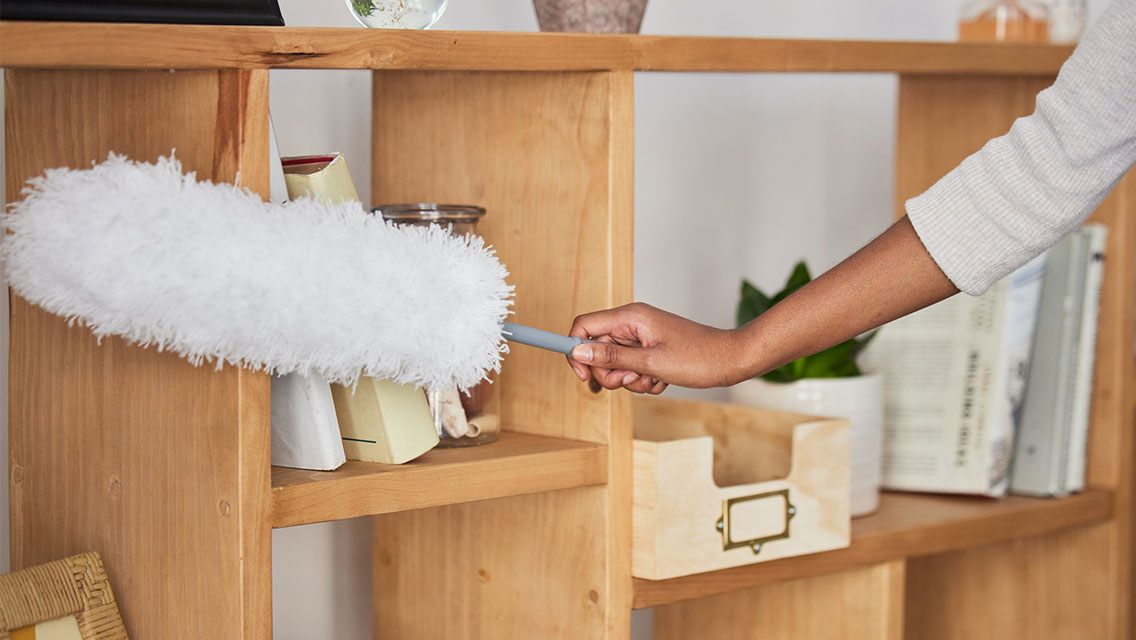A lot of attention has been given to “sick building syndrome,” in which folks working in tightly sealed offices develop various health problems. Less recognized is that the average American home can also be “sick” from the toxic products we unwittingly use every day.
So, next time you get back from a rejuvenating workout at the gym, take a minute before whipping up your postworkout smoothie to consider how your home environment may be interfering with your health goals.
Americans can have some 104 toxic chemicals coursing through their bodies at any given time, according to the Centers for Disease Control and Prevention. These environmental toxins poison our crucial energy-producing mitochondria, leading to fatigue and weight gain, says Walter Crinnion, ND, author of Clean, Green, and Lean: Get Rid of the Toxins That Make You Fat.
Even worse, an ongoing toxic burden is cumulative and can hasten the development of illnesses like type 2 diabetes, cancer, heart disease, and asthma.
When it comes to toxins, says Crinnion, it’s all about total load. The body is built to detoxify a certain amount of chemicals, but when it becomes overwhelmed, a switch is triggered and disease sets in.
“What’s the last bit of chemical that’s going to be the straw that breaks the camel’s back?” asks Crinnion, who is also director of the Environmental Medicine Center of Excellence at the Southwest College of Naturopathic Medicine & Health Sciences in Tempe, Ariz. “No one knows until they’ve had one exposure too many.”
Crinnion specializes in treating illnesses caused by environmental burden, and in taking his patients’ case histories, he’s come to see that “their exposures are no different than mine.” In other words, living a typical American life brings us into daily contact with multiple toxins.
The good news is that most of the toxins in our homes are water soluble, which means they easily flush from our bodies once we limit exposure. What’s crucial is that you keep an eye out for the persistent presence of certain chemicals, which can build up over time and lead to illness.
To evaluate the chemical load of your home, try returning to the fundamentals on the following pages to establish a healthy balance with the elements. As Paula Baker-Laporte, coauthor of Prescriptions for a Healthy House: A Practical Guide for Architects, Builders & Homeowners, reminds us, “The basic job of our home is to shelter us from the elements of fire, earth, air, and water, and then to reintroduce those elements back to us in a benign way.”
With that in mind, here are some ideas to consider for detoxing your abode.
Air
“What do you smell when you first walk into your house?” asks Baker-Laporte. “Your house should smell pleasant. If it smells moldy or dusty or has a chemical smell, there’s a problem.”
A spate of studies indicate that indoor air is two to five times more polluted than outdoor air. In part, this is because our indoor air has become compromised by the synthetic chemicals in building materials and other products used in the home. Making matters worse is that, in response to the energy crisis of the 1970s, many buildings were sealed tightly to conserve energy, which also had the unintended effect of trapping toxins in our living environments.
Filter Out the Bad Stuff
The ideal defense, of course, would be to eliminate toxins altogether. But some degree of chemical exposure is inevitable. Daniel Stih, an environmental consultant, recommends taking a quick trip to your local hardware store: “I know this sounds like a no-brainer,” says Stih, author of Healthy Living Spaces: Top 10 Hazards Affecting Your Health, “but change the filter on your furnace. Find it, change it, and upgrade it to an allergy-reduction filter.” Stih explains that cheap filters protect the furnace only from dirt that could gum up the moving parts — not the air you’re breathing. HEPA (high-efficiency particulate air) filters, however, remove the tiny particles that can be especially toxic.
Also have air ducts and vents cleaned, but skip the unnecessary chemical sanitizer. For the bedroom, an air purifier with both charcoal and HEPA filters is a good investment.
Forgo Artificial Scent
Beware fragrances. Perfumed items such as air fresheners (particularly plug-in diffusers) and scented laundry soap are some of the chief compromising indoor air quality. Many products simply list “fragrance” as an ingredient, says Stih, and that term often includes chemicals such as formaldehyde and odorless fixatives that stabilize the chemical compound but also irritate the eyes and mucous membranes.
If you enjoy scents, Stih notes that organic, therapeutic-grade essential oils are a good alternative. Mix a few drops in a spray bottle with water, and voilà — a natural aerosol deodorant. (For more on the dangers of fragrances, see “Dryer Dangers”.)
Reduce Indoor Chemical Exposures
Paint is a common source of indoor air pollution. Choose a low-or zero-VOC paint certified by Green Seal to exclude certain heavy metals and toxic compounds. Or consider a paint derived from natural sources, such as milk paint.
Furniture made of particleboard or foam can off-gas chemicals for years. Opt instead for solid wood, and use bedding made of organic cotton.
Check your basement for radon, an odorless radioactive gas that can seep from the ground into homes and also contaminate groundwater. This is especially true for folks in the heartland: Soil in the Midwest is high in uranium, which eventually breaks down to form radon.
Air It Out
Outside air is one of the best things to improve the air quality of your home, says Baker-Laporte. So, unless you live by a freeway, open a window.
You can also try a little indoor gardening. Certain houseplants, such as English ivy, bamboo palm, and spider plants, can filter pollutants from the air.
(Try these simple steps to clear the air inside your house at “11 Tips to Improve Indoor Air Quality“.)
Fire
Fire — at least a natural-gas version of it — heats many of our homes, helps us cook our food, and warms the water for our morning showers. But, Baker-Laporte warns, “any source of indoor combustion will release a certain amount of toxic byproducts.”
Use Gas With Caution
Natural gas is a major source of indoor air pollution — one that Crinnion has found directly causes or exacerbates asthma and other breathing problems for many of his patients. Replacing gas appliances with electric ones may be the best solution, especially for people with chemical sensitivities or respiratory issues. Electric power can also have the added benefit of being less expensive (check out an on-demand, tankless water heater) and more environmentally friendly.
For people who are otherwise healthy, gas-fired cooking can be relatively safe if certain precautions are observed. Newer stoves that don’t rely on a continuously burning pilot light decrease the likelihood of leaks. And pay attention to the color of the flame: A properly functioning burner creates combustion through a balanced mix of air and fuel, producing a blue flame. Yellow signals incomplete combustion — and the production of carbon monoxide. Make sure to install a hood above the stove that vents to the outside.
For a gas furnace or water heater, Stih recommends a sealed combustion unit with a power exhaust fan, as well as a nearby carbon-monoxide detector. (See “What Is the Impact of Natural Gas on Human Health?” for more.)
Put Out Fire-Retardant Hazards
Our fear of fire has actually led us to develop new chemical hazards, such as fire-retardant polybrominated-diphenyl ethers (PBDEs), which are found in plastic electronics and highly flammable synthetic materials. Scientists have found that even tiny amounts are damaging to children’s developing bodies, so don’t let the little ones chew on your cell phone or TV remote.
PBDEs are also of heightened concern because they are one of the few chemicals in our homes that are not water soluble and thus don’t flush out of our bodies easily. Rather, they hang out in our fat cells indefinitely.
Although many companies are responding by using less-toxic chemicals, be aware that foam products made before 2005 are the most hazardous. Also, removing old carpet requires special care, since the padding is likely to contain brominated fire retardants.
Water
Eight fresh glasses of water daily is one of the best-known health tonics, and a long bath can be one of life’s most sublime pleasures. Water can also be a source of toxins in the home, however.
Purify Your H2O
The safety of your tap water depends on where you live. More than 90 percent of water systems meet Environmental Protection Agency (EPA) standards. But, according to independent analysis by the Environmental Working Group (EWG), even cities with top-rated water utilities still have pollutants in their drinking water.
In general, a good-quality carbon filter, if changed frequently, can remove toxins such as lead and chlorine from drinking water. A more-expensive reverse-osmosis system may be necessary to rid your water of contaminants with smaller molecules, such as nitrates.
Many experts also believe a shower filter is crucial, because some toxins, such as chlorine, become even more dangerous when converted into steam. Given this fact, another, albeit more-expensive, option is a whole-house carbon filter.
Type your ZIP code and the name of your local water utility into the National Drinking Water Database on the EWG website (www.ewg.org) to get specifics about what’s coming out of your faucet. The EPA Safe Drinking Water Hotline (800-426-4791) is another helpful resource.
Beware Mold
“Mold in a home is just devastating,” says Crinnion, who links this often-hidden enemy to many serious health conditions, including asthma, compromised immunity, and neurological problems. Plumbing leaks are one of the leading causes of mold growth, so check for them under kitchen and bathroom sinks, around water heaters, and behind washing machines and dishwashers. Crinnion explains that old or cracked caulking around a shower can turn the drywall into a giant sponge.
“Drywall is like baby food for mold,” says Stih, who notes it is much more difficult for mold to break down a solid piece of wood. Once mold infects drywall, the only way to get rid of it is to cut out that section of the wall. Other infected porous materials, such as carpeting or ceiling tiles, will probably also need to be thrown out.
The EPA recommends cleaning mold off nonporous surfaces with simple soap and water and then drying them completely. But mold found on porous surfaces is often best left to a professional, since improper cleanup can actually spread the mold spores.
To prevent the return of mold, Stih says, “Keep things dry. Period.” This means repairing plumbing leaks, regularly cleaning gutters to allow water to flow away from your house, and keeping indoor humidity below 50 percent. (To learn more about the negative affects of mold, see “It Could Be Mold“.)
Earth
We enjoy connecting with the earth through a landscaped yard or natural park. Once we track that earth inside, though, it’s a different story. Dirt, in this chemical age, is dirtier than many of us might want to know.
Clear the Deck
One of the easiest things you can do to prevent pesticides and other contaminants from entering your home is to take your shoes off at the door. Wall-to-wall carpeting, in addition to being made with extremely toxic chemicals, also turns out to be an excellent repository for dirt, toxins, and mold spores.
Ripping out all the carpet in your home can be a big step, so remove it from the bedrooms first, since we spend about seven or eight hours a night there. Children’s bedrooms are especially important, since babies and young children are especially susceptible to toxins while developing neurologically; also, because they are smaller, the chemical load they absorb is proportionally larger. Young kids live their lives closer to the ground, and therefore closer to the dangers posed by carpets.
If carpet removal isn’t an option, clean frequently with a vacuum fitted with a HEPA filter, and change that filter often. A regular vacuum might actually do more harm than good, recirculating allergens back into the air.
Dust Up Toxins
Ignoring the dust bunnies behind your couch might be a little harder to do once you know what’s actually in them. Besides pet dander, mold spores, and human hair and skin, one study found 35 toxic industrial chemicals that have been shown to cause reproductive, respiratory, and other health problems in humans and animals. The most common chemicals were phthalates, which are plasticizers used to soften vinyl. The chemicals arrive on your feet (take your shoes off at the door), through windows and doors, and from products inside your home that “shed” chemicals with use.
To prevent dust-bunny proliferation, mop floors and wipe down furniture with a wet cotton or microfiber cloth.
Kill Pests Kindly
Pesticides and herbicides may work on their intended targets, but they can wreak havoc on human bodies as well. Try less toxic measures. Getting to know your bugs is the first step in eradicating them. Identify what the pest is, learn its habits, and get to the root of the problem. For example, Baker-Laporte notes, termites tend to invade a house that already has too high a moisture level. The Pesticide Action Network (www.panna.org) is a helpful resource for other alternatives, offering specific remedies for eradicating everything from ants to yellow jackets.
Clean the Old-Fashioned Way
We’ve gotten to the point where our aversion to dirt has prompted us humans to develop cleaning products that pose their own hazards. Pine- and citrus-based-oil cleaners, for example, can produce cancer-causing formaldehyde. The active ingredient in antibacterial soap is triclosan, which is linked to liver toxicity and, at low levels, may disrupt thyroid function.
To find products that are truly “green” — for the environment and for you — look for the Green Seal or EcoLogo, which indicate independent certifications.
Or, do like Grandma did, and make your own cleaning products. Diluted white vinegar is great for washing windows, and baking soda with water makes a paste that’s handy for scrubbing. And, when it comes to washing your hands, plain old soap and water will do just fine. (Clean your home safely — and cheaply — with these recipes at “6 DIY Cleaner Recipes“.)




This Post Has 0 Comments